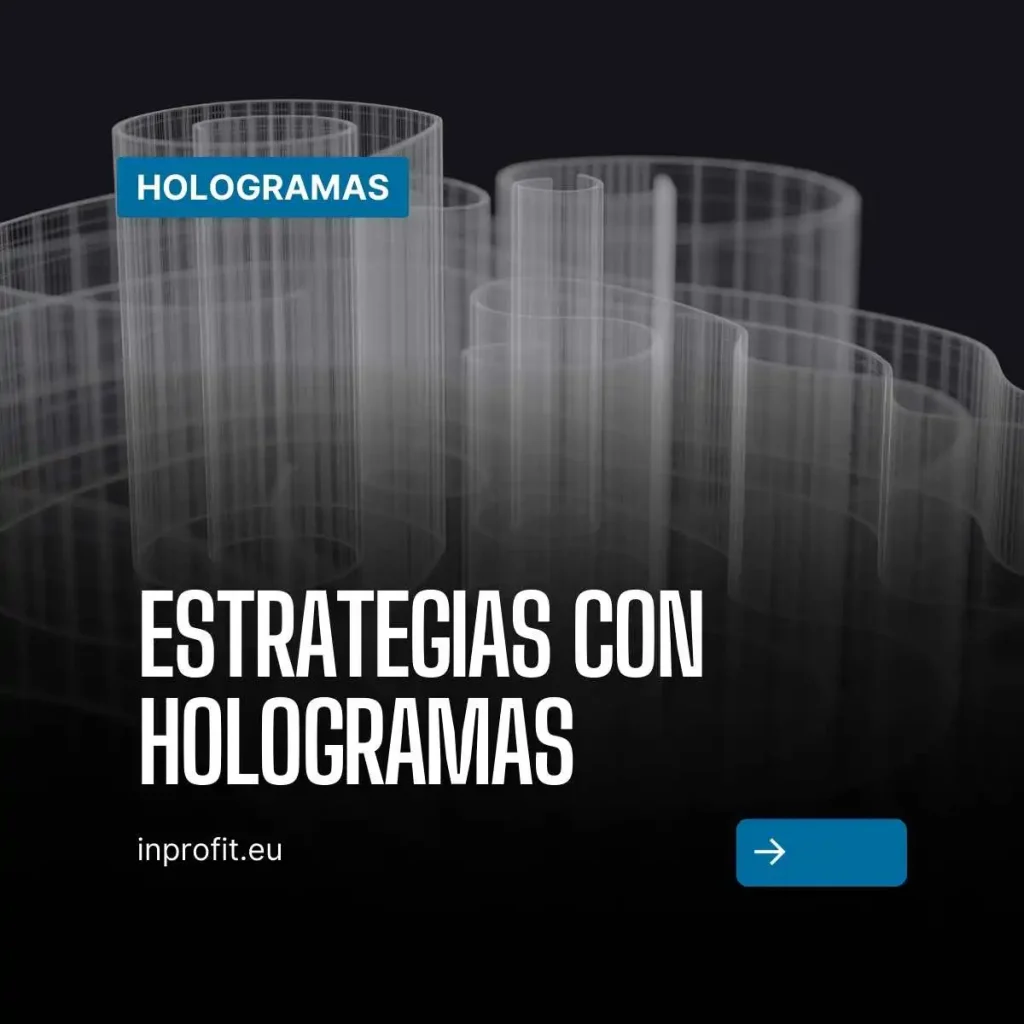These are not just floating images that capture eyeballs, but strategic solutions that transform industries such as marketing, education, medicine and entertainment. From visualizing prototypes in industrial design to creating breakthrough customer experiences, holograms offer a three-dimensional canvas for creativity and functionality.
In this article, we will explore practical and specific strategies for integrating these technologies into technology projects, optimizing their impact and overcoming common barriers. If you are looking to take your initiatives to the next level, this tour will provide you with a clear roadmap for harnessing the potential of holograms.
Immersive holograms
Holograms are not a new concept, but their accessibility and versatility have grown exponentially thanks to advances in hardware and software. They are no longer confined to laboratories or high-budget shows; today, companies of all sizes can deploy them to solve real problems and engage audiences.
We guide you step-by-step: from initial planning to execution, from choosing tools to measuring results. With a focus on practical applications and human language that avoids unnecessary technicalities, we’ll break down how to make holograms work for you, without falling into empty promises or generic tech jargon. Get ready to discover how these projections can become the heart of your next immersive project.
The key is in the strategy: it is not enough to acquire a holographic projector or state-of-the-art software. It is about aligning this technology with specific objectives, whether it is to increase engagement, optimize processes or differentiate your brand.
Strategic planning for holographic projects
Before diving into implementation, clearly define your objectives. Do you want to capture attention at a trade show, facilitate interactive trainings or improve data visualization? Each goal requires a different approach. For example, a retailer might use holograms to display products in 3D, while a museum might recreate historical artifacts.
It starts with a needs analysis: identify the target audience, the context of use and the expected results. This ensures that the technology is not an end in itself, but a means to solve specific problems.
The next step is to evaluate the environment. Holograms work best in controlled conditions: moderate lighting, spaces without excessive vibrations, and suitable displays (such as holographic films or spatial light modulators). For example, at an outdoor event, an ionized fog hologram might be more effective than a laser-based one. Consider also the interaction: will it be passive, like an advertising display, or active, with gestural controls? Tools like Unity or Unreal Engine, combined with augmented reality SDKs like ARKit, allow you to create interactive experiences that adapt to gestures or voice commands.
Finally, set a realistic budget. Costs range from low-cost devices such as holographic fans (2000 EUR) to advanced systems (from 10,000 EUR). For projects with limited resources, consider cloud-based solutions that reduce the need for proprietary hardware.
Tools of the future: Technologies for implementation
Selecting the right technology is crucial for success. Digital holograms, generated by software, are the most accessible for modern projects. Platforms such as Blender allow 3D objects to be modeled and then converted into holograms using diffraction algorithms. For real-time interactions, spatial light modulators (SLMs) are essential, as they manipulate light waves to create dynamic projections. Brands such as Sony and Texas Instruments offer affordable SLMs for developers.
If you are looking for portability, devices such as Microsoft’s HoloLens 2 or Magic Leap 2 integrate holograms with augmented reality, ideal for mobile applications such as maintenance guides or educational simulations. These systems use sensors to map environments, adjusting the projections to the physical space. For example, in a factory, a technician could visualize a holographic engine superimposed on the real machine, facilitating repairs.
For large-scale projects, such as stadium installations, volumetric holograms based on plasma or fog displays offer wide viewing angles without the need for glasses. Companies such as Leia Inc. are developing displays that combine nanotechnology with holographic projections, ideal for immersive advertising. Be sure to integrate analytics software to measure impact, such as user interaction time or conversion rates in marketing campaigns.
- Recommended platforms: Unity, Unreal Engine, Blender.
- Accessible hardware: Holographic fans, Looking Glass Portrait.
- Cloud services: HoloVizio, Azure Mixed Reality.
Successful case studies
In retail, holograms are redefining the customer experience. Zara implemented holographic displays in its flagship stores, projecting outfits that customers can “try on” virtually. This not only increased engagement by 25%, according to internal data, but also reduced returns by enabling previews.
The strategy was simple: use low-cost holographic fans combined with a pre-rendered 3D catalog, implemented in less than three months.
In education, Cambridge University uses holograms to teach anatomy. Students interact with 3D models of organs, rotating and dissecting them virtually. The key was to integrate HoloLens with custom software that translates CT scan data into holograms. This reduced learning time by 15% versus traditional methods, according to a 2024 study. The strategy included teacher training to maximize adoption.
In entertainment, ABBA Voyage’s holographic concert in London is a benchmark. Using volumetric projections and motion capture, they created realistic avatars that act in real time. The strategy combined high-end hardware (laser projectors) with a team of 3D artists and AI specialists to synchronize movements. The result: more than one million attendees in its first year.

How to overcome common barriers?
Implementing holograms is not without its challenges. The initial cost can be prohibitive, especially for SMEs. An effective strategy is to start with low-cost solutions, such as mobile AR applications that simulate holograms on smartphones. For example, 8th Wall’s Holo app allows you to create holographic experiences without dedicated hardware, ideal for startups.
The user experience also requires attention. Visual fatigue, caused by prolonged viewing, can be mitigated by adjusting brightness and limiting sessions to 30 minutes. Also, make sure interfaces are intuitive: A/B tests have shown that simple gesture controls (such as pinch-to-zoom) increase user satisfaction by 20%. Companies such as Ultraleap offer affordable gesture tracking sensors.
Finally, privacy is a growing concern. Interactive holograms often collect biometric data, such as eye movements. Implement clear consent policies and use digital watermarking to ensure the authenticity of projections, especially in sensitive applications such as telemedicine.
- Low-cost strategies: AR Apps
- UX improvements: Simple gesture controls, short sessions.
- Security: Watermarking and biometric data encryption.
Scaling and optimizing impact
Once implemented, the next step is to scale. Start with small pilots: an in-store hologram or training. Measure key metrics, such as interaction time or ROI in advertising campaigns. For example, Nike reported an 18% increase in sales after using holograms to display sneakers at events. Use these metrics to justify larger investments.
Integration with AI is a powerful strategy. Predictive algorithms can personalize holograms in real time, such as displaying products based on user preferences. In medicine, AI can generate dynamic holograms from patient data, improving diagnostics. Tools such as TensorFlow, combined with holographic SDKs, facilitate this integration.
Finally, it fosters interdisciplinary collaboration. Designers, engineers and UX specialists must work together to create coherent experiences. Programs such as the MIT Media Lab, which brings together artists and technologists, have generated innovative holographic solutions, such as displays that respond to the user’s emotional state.
Innovate your strategy with holograms
Holograms are not just a technology; they are a strategy to connect, educate and amaze. From in-store displays to surgical simulations, their implementation requires planning, the right tools and a focus on the user. By adopting these strategies, you can transform technology projects into immersive experiences that make a difference.
For innovators, the message is clear: start small, measure results and scale smartly. Share your ideas in the comments: how do you plan to use holograms in your next project? Visit our website for more guides and stay up to date with trends in immersive technology. The future is not just seen; it’s projected in three dimensions.




